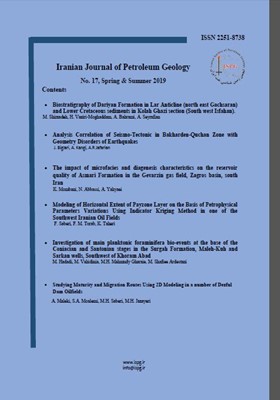The impact of microfacies and diagenesis characteristics on the reservoir quality of Asmari Formation in the Gevarzin gas field, Zagros basin, south Iran
Subject Areas : Petroleum Reservoir GeologyKarim Mombani 1 , 2 * , Ahmad Yahyaei 3
1 -
2 -
3 -
Keywords: Asmari Formation Microfacies Carbonate Ramp Diagenesis Reservoir Quality Gavarzin gas field,
Abstract :
Asmari Formation from the Gavarzin gas field have erosional unconformity boundary on marl and pelagic limestones of Pabdeh Formation and gradually change to evaporate cap rock of Gachsaran Formation. Cores studies from the one of wells of Gavarzin field is 183 m in thickness, which includes 1.30 m from the top of Pabdeh, 162.4 m from the Asmari Formation and 19.30 m from the base layers of Gachsaran. Asmari Formation includes alternation of limestone, calcite dolomitic, claystone and shale with green marl. Petrology and facies analysis of the sequence of these formations identified 12 microfacies, a carbonate ramp from deep-sea to sabkha environments and formed in a retrograded sequence. This ramp includes deep environments, open sea, patch reef, bio-, clastic-bars, lagoon and tidal environments, which confirms a changing environment due to rapid facies changes and deposition of evaporative sediments in Gachsaran as a restricted environment. Diagenesis processes are considered as the main factors in carbonate reservoir quality of Gavarzin field. The diagenesis history of the Asmari carbonates of the studied cores is summarized as A) marine phreatic diagenesis, bioturbation, micritization and cementation processes occurred. B) vadose zone diagenesis, where the crystallization, cementation, and dissolution occurred. C) burial diagenesis, comprises compression-induced, pressure dissolution and fracturing are common. The microfacies show a wide varieties of reservoir characteristics and therefore a heterogeneous reservoir has been formed. Micro-fractures, however have strongly influence on the reservoir quality in the section. The simultaneous presence of dissolved spaces and fractures in the reservoir the permeability greatly increased. The best reservoir quality in the Grainstone/Packston facies are coated grains with moldic porosity that were created by the leaching of Ooid-bearing Packston lithology during the diagenesis of atmospheric waters.

